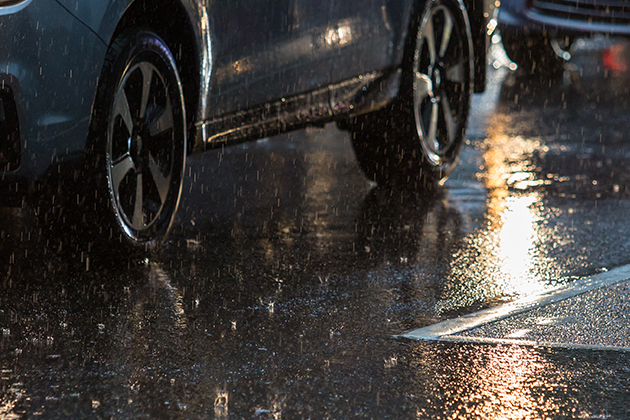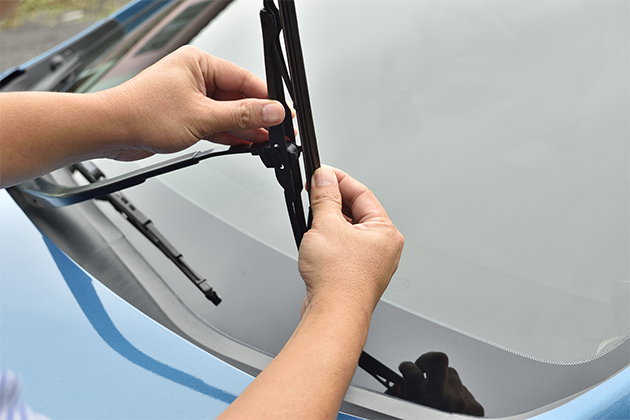Would you know what to do if your car started aquaplanning on a flooded road?
Driving during stormy conditions, when there is heavy rain, wind and lightning, can affect the control you have over your vehicle, reduce your visibility, increase traffic congestion and can be stressful for whoever is behind the wheel.
Understanding just how to keep yourself and others safe while driving in wet and stormy weather is essential, and can also help prevent your car from being damaged by water.
Driving on flooded roads
The risks associated with driving on heavily flooded roads should never be underestimated, even in urban areas.
If you’re faced with driving through a section of road that is heavily flooded, it’s always best to turn around and find another route if possible.
Driving on flooded roads at night is especially dangerous as it can be even harder to gauge the depth.
Water as shallow as 15cm can be dangerous to drive through, not just because of the damage it may do to your car but also the danger it may pose to you and others inside the car.
The force of even slow-moving water pressing against your car can be a lot more powerful than you realise. In regional areas, water may also undermine road surfaces.
Your vehicle’s maximum wading depth should be in the owner’s manual, but as a guide, if the water is deep enough to reach the bottom of the doors, don’t drive through.
You could risk damage to the engine and other major parts, and the car’s electrical systems. If water enters the engine, severe damage can be caused, which could require you to replace or rebuild the engine. Water may also affect electric windows and door locks, which could become a safety issue if you get stuck.
If you have no choice but to drive through and you can gauge that the water level isn’t high enough to be dangerous, drive through slowly to reduce the chances of water being forced up into places it shouldn’t go.
Once you’re through, apply light pressure to your brakes to test that they haven’t been affected, stick to a safe speed and remember to keep a good distance from any cars in front of you.
Driving during a storm
If you get caught driving in a storm and are having difficulty clearly seeing the road ahead, pull over to a safe location and turn on your hazard lights. Be careful to pick a safe spot, as everyone’s visibility will be reduced and avoid seeking shelter beneath trees or under other structures that could be become unstable in heavy wind.
If you’re unable to pull over safely:
- Turn on your headlights. The law requires drivers to turn on their headlights in hazardous weather conditions which restrict visibility. Not only will headlights help you see the road, they’ll help other drivers see your vehicle.
- Leave a safe distance. Wet weather affects your vehicle's stopping distance and also the control you have over your vehicle if you suddenly brake, so leave extra space between you and the car in front of you. Lower your overall speed to better suit the conditions and give you more time to stop safely.
- Avoid puddles. Don’t drive into water of unknown depth or over water-filled potholes. It's unsafe for you and your passengers and could damage your vehicle. If you're moving lanes to avoid puddles, be sure to indicate so other drivers know of your intentions.
- De-mist your front and rear windscreen. Use your air conditioner to de-mist your front windscreen most efficiently and switch on your rear demister to ensure you have good visibility through all windows.
How to manage aquaplaning
Aquaplaning occurs when water builds up under your tyres faster than the tyre tread can push it away through the grooves. Instead, water builds beneath the tyre until it can no longer maintain contact with the road.
With no grip, you could lose control. If you feel your car begin to aquaplane:
- Don't brake harshly. It might be your first instinct to bring your car to a halt, but this could cause it to skid and spin.
- Slowly ease off the accelerator. This will help you slow down safely. If you do accelerate, this will reduce grip even further.
- Don't try turning the steering wheel. Keep a solid grip on the steering wheel and hold it still until you re-gain control of the car.

Before storm season
- Check your tyre pressure and tread. As the only contact between you and the road, it’s important your tyres are in good condition before driving on wet roads. Regularly check that your tyres are at the recommended pressures. You can find this information inside your owner's manual, where it will be shown in PSI, kPa or both. Also make sure your tyre tread depth meets the minimum legal limit of 1.5mm. Ideally you shouldn't let it get any lower than 3mm.
- Check your windscreen wipers. If your wipers are damaged or not functioning properly, replace them before driving in wet weather. You can get this done at any RAC Auto Services centre – and if you’re a member you save 10% off labour.
- Check your lights. Regularly check all of your vehicle's lights, including headlights, brake lights and indicators.
RELATED: Preparing your car for winter »

Who to contact in case of an emergency
Critical assistance: State Emergency Services (SES) 132 500
Land weather and flood warnings: Bureau of Meteorology 1300 659 213
Road conditions: Main Roads WA 138 138
Vehicle breakdown: RAC Roadside Assistance 13 11 11
Is your car ready for storm season?
RAC members save 10% on their car service at RAC Auto Service centres.
Last updated: May 2022
